重庆医科大学:《诊断学》课程教学资源(授课教案)04 便血

置庆医科大学脑床半院藏未讲满 重庆医科大学临床学院教案及讲稿 课程名称诊断学 年级2005 授课专业临床医学 教师古赛 职称剧教授授课方式大课 学时1 题目章节消化道出血一 一便血 教材名称《诊断学(双语)》 作者吕卓人雷寒 出版社科学出版社 版次第一版 教学目的要求 To get familiar with causes of hematochezia To master the relationship between the coor of bloody stools and bleeding part Clinic manifestation of hematochezia 2 The simultaneous phenomenon of hematochezia and the relation with etiopathogenisis 点 Main points of inquiring hematochezia the volume of hematochezia and ②TnierelaionbcenthecoilotofhcmaiochcZianadbiaifd ts of the hole body 3 intestine,disease of colon,disease ofrectum and anus,systemtic disease 要求 English Power point,pictures and forms 手段 《现代胃肠病学》潘国字,曲世殖主编。北京:科学出版社1994. 参考 资料 3 教研 室意 制表时间:2005年8月
重庆医科大学临床学院教案讲稿 制表时间:2005 年 8 月 1 重庆医科大学临床学院教案及讲稿 课程名称 诊断学 年级 2005 授课专业 临床医学 教 师 古赛 职称 副教授 授课方式 大课 学时 1 题目章节 消化道出血——便血 教材名称 《诊断学(双语)》 作者 吕卓人 雷寒 出 版 社 科学出版社 版次 第一版 教 学 目 的 要 求 1 To get familiar with causes of hematochezia 2 To master the relationship between the color of bloody stools and bleeding part 教 学 难 点 1 Clinic manifestation of hematochezia 2 The simultaneous phenomenon of hematochezia and the relation with etiopathogenisis 3 Main points of inquiring hematochezia 教 学 重 点 1 The definitions of hematochezia 2 Clinic manifestation of hematochezia: ① The relation between the volume of hematochezia and general symptoms ② The relation between the color of hematochezia and bleeding parts of the hole body ③The problems of occult blood test which should be pay attention to 3 The common etiopathogenisis of hematochezia: disease of upper digestive tract、disease of intestine、disease of colon、disease of rectum and anus、systemtic disease 4 The simultaneous phenomenon of hematochezia and the relation with etiopathogenisis 5 Main points of inquiring hematochezia 外语 要求 English 教学 方法 手段 Power point, pictures and forms 参考 资料 1 《现代胃肠病学》.潘国字,曹世殖主编。北京:科学出版社. 1994. 2 Walter L. Peterson. Gastrointestinal hemorrhage [M]. TEXTBOOK of MEDICINE, 18th edition, edited by James B. Wyngaarden and Lloyd H. Smith. 1988, W.B. Saunders company. 796-799. 3 Loren Laine. Acute and Chronic Gastrointestinal Bleeding. Sleisenger& Fordtran’s Gastrointestinal and Liver Disease, 6th edition, volume 2, edited by Mark Feldman, Bruce F. Scharschmid t and Marvin H. Sleisenger. 2001, W.B. Saunders company. 198-219 教研 室意 见
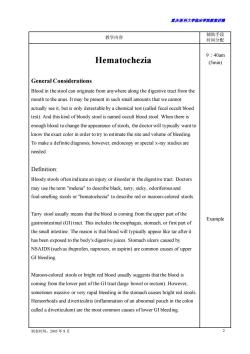
露庆医科大学临床半蕊载案讲满 教学内容 9:40am Hematochezia (5min) General Considerations Blood in the stool can originate from anywhere along the digestive tract from the mouth to the anus.It may be present in such small amounts that we cannot actually see it,but is only detectable by a chemical test (called fecal occult blood test).And this kind of bloody stool is named occult blood stool.When there is enough blood to change the appearance of stools,the doctor will typically want to know the exact color in order totry to estimate the site and volume of bleeding. To make a definite diagnosis,however,endoscopy or special x-ray studies are needed. Definition: Bloody stools often indicatean injury or disorder in the digestive tract.Doctors may use the term"melena"to describe black,tarry,sicky,odoriferous and foul-smelling stools or"hematochezia"to describe red or maroon-colored stools Tarry stool usually means that the blood is coming from the upper part of the Example gastrointestinal(GI)tract.This includes the esophagus,stomach,or first part of the small intestine.The reason is that blood will typically appear like tar after it has been exposed to the body's digestive juices.Stomach ulcers caused by NSAIDS(such as ibuprofen,naproxen,or aspirin)are common causes of upper GI bleeding. Maroon-colored stools or bright red blood usually suggests that the blood is oming from the lower part ofthe GI tract(large bowel or rectum).However, sometimes massive or very rapid bleeding in the stomach causes bright red stool Hemorrhoids and diverticulitis(inflammation of an abnormal pouch in the colon called a diverticulum)are the most common causes of lower GI bleeding. 制表时间:2005年8月
重庆医科大学临床学院教案讲稿 制表时间:2005 年 8 月 2 教学内容 辅助手段 时间分配 Hematochezia General Considerations Blood in the stool can originate from anywhere along the digestive tract from the mouth to the anus. It may be present in such small amounts that we cannot actually see it, but is only detectable by a chemical test (called fecal occult blood test). And this kind of bloody stool is named occult blood stool. When there is enough blood to change the appearance of stools, the doctor will typically want to know the exact color in order to try to estimate the site and volume of bleeding. To make a definite diagnosis, however, endoscopy or special x-ray studies are needed. Definition: Bloody stools often indicate an injury or disorder in the digestive tract. Doctors may use the term "melena" to describe black, tarry, sicky, odoriferous and foul-smelling stools or "hematochezia" to describe red or maroon-colored stools. Tarry stool usually means that the blood is coming from the upper part of the gastrointestinal (GI) tract. This includes the esophagus, stomach, or first part of the small intestine. The reason is that blood will typically appear like tar after it has been exposed to the body's digestive juices. Stomach ulcers caused by NSAIDS (such as ibuprofen, naproxen, or aspirin) are common causes of upper GI bleeding. Maroon-colored stools or bright red blood usually suggests that the blood is coming from the lower part of the GI tract (large bowel or rectum). However, sometimes massive or very rapid bleeding in the stomach causes bright red stools. Hemorrhoids and diverticulitis (inflammation of an abnormal pouch in the colon called a diverticulum) are the most common causes of lower GI bleeding. 9:40am (5min) Example

重庆医科大半脑床半院载未讲满 Paradoxical Hematochezia Example Consuming black licorice,lead,iron pills,bismuth medicines like Pepto-Bismol or blueberries can also cause black stools.Beets and tomatoes can sometimes make stools appear reddish.In these cases,doctor can test the stool witha chemical test to rule out the presence of blood. Causes A:Lower GI tract disease:(usually maroon or bright red,bloody stools): 9:45am Intestinal disease:Intestinal infection(such as bacterial enterocolitis) (8min) Picture Diverticular bleeding Colon diseases:Colon polyps or colon cancer,inflammatory bowel disease Rectum diseases:Hemorrhoids,Anal fissures Vascular malformation of gut: Bowel ischemia:(a lack of proper blood flow to the intestines) B:Upper GI tract (usually black stools): Bleeding stomach or duodenalulcer ●Gastritis ●Esophageal varices Mallory-Weis tear (atear in theesophagus from vioent vomiting) /ascular malformation C:Systemic disease ●Hemorrhagic disease ●Infectious disease Common causes: The cause of these lesions is dependent both upon the age of the patient and the severity of the bleeding.In patients under 50 years ofage,the most common causes are infectious colitis,anorectal disease,and inflammatory bowel disease In older patients,significant hematochezia is most often seen with diverticulosis vascular ectasias,malignancy,or ischemia. (a)Diverticulosis: 制表时间:2005年8月
重庆医科大学临床学院教案讲稿 制表时间:2005 年 8 月 3 Paradoxical Hematochezia Consuming black licorice, lead, iron pills, bismuth medicines like Pepto-Bismol, or blueberries can also cause black stools. Beets and tomatoes can sometimes make stools appear reddish. In these cases, doctor can test the stool with a chemical test to rule out the presence of blood. Causes A: Lower GI tract disease:(usually maroon or bright red, bloody stools): ⚫ Intestinal disease: Intestinal infection (such as bacterial enterocolitis), Diverticular bleeding ⚫ Colon diseases: Colon polyps or colon cancer, inflammatory bowel disease ⚫ Rectum diseases: Hemorrhoids, Anal fissures ⚫ Vascular malformation of gut: ⚫ Bowel ischemia: (a lack of proper blood flow to the intestines) B: Upper GI tract (usually black stools): ⚫ Bleeding stomach or duodenal ulcer ⚫ Gastritis ⚫ Esophageal varices ⚫ Mallory-Weiss tear (a tear in the esophagus from violent vomiting) ⚫ Vascular malformation C: Systemic disease: ⚫ Hemorrhagic disease ⚫ Infectious disease Common causes: The cause of these lesions is dependent both upon the age of the patient and the severity of the bleeding. In patients under 50 years of age, the most common causes are infectious colitis, anorectal disease, and inflammatory bowel disease. In older patients, significant hematochezia is most often seen with diverticulosis, vascular ectasias, malignancy, or ischemia. (a) Diverticulosis: Example 9:45am (8min) Picture
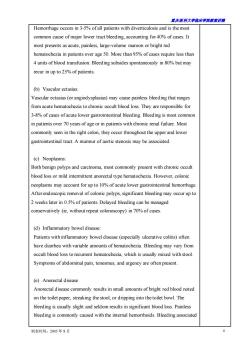
重庆医科大学临床半院教来讲满 Hemorrhage occurs in 35%ofall patients with diverticulosis and is the most common cause of major lower tract bleeding,accounting for 40%of cases.It most presents as acute.painless.large-volume maroon or bright red hematochezia in patients over age 50.More than95%of cases require less than 4 units of blood transfusion.Bleeding subsides spontaneously in%but may recur in up to5%of patients. (b)Vascular ectasias: Vascular ectasias(or angiodysplasias)may cause painless bleeding that ranges from acute hematochezia to blood loss.They are responsible for 3-8%of cases of acute lower gastrointestinal bleeding.Bleeding is most common in patients over 70 years of age or in patients with chronic renal failure.Most commonly seen in the right colon,they occur throughout the upper and lower gastrointestinal tract.A murmur of aortic stenosis may be associated. (c)Neoplasms: Both benign polyps and carcinoma,most commonly present with chronic occult olood loss or mild intermittent anorectal type hematochezia.However,colonic neoplasms may account for up to 10%of acute lower gastrointestinal hemorrhage Afterendoscopic removal of colonic polyps,significant bleeding may occur up to 2 weeks later in%of patients.Delayed bleeding can be managed conservatively (ie,without repeat colonoscopy)in0%of cases. (d)Inflammatory bowel disease: Patients with inflammatory bowel disease (especially ulcerative colitis)often have diarrhea with variable amounts of hematochezia.Bleeding may vary from occult blood loss to recurrent hematochezia,which is usually mixed with stool. Symptoms of abdominal pain,tenesmus,and urgency are often present (e)Anorectal disease Anorectal disease commonly results in small amounts of bright red blood noted on the toilet paper.streaking the stool or dripping into the toilet bowl.The bleeding is usually slight and seldom results in significant blood loss.Painless bleeding is commonly caused with the interal hemorrhoids.Bleeding associated 制表时间:2005年8月
重庆医科大学临床学院教案讲稿 制表时间:2005 年 8 月 4 Hemorrhage occurs in 3-5% of all patients with diverticulosis and is the most common cause of major lower tract bleeding, accounting for 40% of cases. It most presents as acute, painless, large-volume maroon or bright red hematochezia in patients over age 50. More than 95% of cases require less than 4 units of blood transfusion. Bleeding subsides spontaneously in 80% but may recur in up to 25% of patients. (b) Vascular ectasias: Vascular ectasias (or angiodysplasias) may cause painless bleeding that ranges from acute hematochezia to chronic occult blood loss. They are responsible for 3-8% of cases of acute lower gastrointestinal bleeding. Bleeding is most common in patients over 70 years of age or in patients with chronic renal failure. Most commonly seen in the right colon, they occur throughout the upper and lower gastrointestinal tract. A murmur of aortic stenosis may be associated. (c) Neoplasms: Both benign polyps and carcinoma, most commonly present with chronic occult blood loss or mild intermittent anorectal type hematochezia. However, colonic neoplasms may account for up to 10% of acute lower gastrointestinal hemorrhage. After endoscopic removal of colonic polyps, significant bleeding may occur up to 2 weeks later in 0.5% of patients. Delayed bleeding can be managed conservatively (ie, without repeat colonoscopy) in 70% of cases. (d) Inflammatory bowel disease: Patients with inflammatory bowel disease (especially ulcerative colitis) often have diarrhea with variable amounts of hematochezia. Bleeding may vary from occult blood loss to recurrent hematochezia, which is usually mixed with stool. Symptoms of abdominal pain, tenesmus, and urgency are often present. (e) Anorectal disease Anorectal disease commonly results in small amounts of bright red blood noted on the toilet paper, streaking the stool, or dripping into the toilet bowl. The bleeding is usually slight and seldom results in significant blood loss. Painless bleeding is commonly caused with the internal hemorrhoids. Bleeding associated
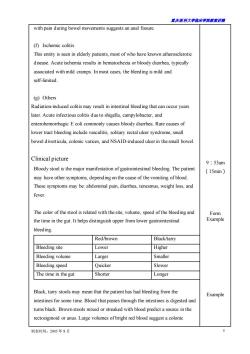
重庆医科大半床半院载未讲满 with pain during bowel movements suggests an anal fissure. (f)Ischemic colitis This entity is seen in elderly patients,most of who have known atherosclerotic disease.Acute ischemia results in hematochezia or bloody diarrhea,typically associated with mild cramps.In most cases,the bleeding is mild and self-limited. (g)Others Radiation-induced colitis may result in intestinal bleeding that can occur years later.Acute infectious colitis due to shigella,campylobacter,and enterohemorrhagic E coli commonly causes bloody diarrhea.Rare causes of lower tract bleeding include vasculitis,solitary rectal ulcer syndrome,small bowel diverticula,colonic varices,and NSAID-induced ulcer in the small bowel. Clinical picture 9:53am Bloody stool is the major manifestation of gastrointestinal bleeding.The patient (15min) may have other symptoms,depend ing on the cause of the vomiting of blood. These symptoms may be:abdominal pain,diarhea,tenesmus,weight loss,and fever. The color of the stool is related with the site,volume,speed of the bleeding and Form the time in the gut.It helps distinguish upper from lower gastrointestinal Example bleeding Red/brown Black/tarry Bleeding site Lower Higher Bleeding volume Larger Smaller Bleeding speed Quicker Slower The time in the gut Shorter Longer Black,tarry stools may mean that the patient has had bleeding from the Example intestines for some time.Blood that passes through the intestines is digested and turns black.Brown stools mixed or streaked with blood predict a source in the rectosigmoid or anus.Large volumes of bright red blood suggest a colonic 制表时间:2005年8月
重庆医科大学临床学院教案讲稿 制表时间:2005 年 8 月 5 with pain during bowel movements suggests an anal fissure. (f) Ischemic colitis This entity is seen in elderly patients, most of who have known atherosclerotic disease. Acute ischemia results in hematochezia or bloody diarrhea, typically associated with mild cramps. In most cases, the bleeding is mild and self-limited. (g) Others Radiation-induced colitis may result in intestinal bleeding that can occur years later. Acute infectious colitis due to shigella, campylobacter, and enterohemorrhagic E coli commonly causes bloody diarrhea. Rare causes of lower tract bleeding include vasculitis, solitary rectal ulcer syndrome, small bowel diverticula, colonic varices, and NSAID-induced ulcer in the small bowel. Clinical picture Bloody stool is the major manifestation of gastrointestinal bleeding. The patient may have other symptoms, depending on the cause of the vomiting of blood. These symptoms may be: abdominal pain, diarrhea, tenesmus, weight loss, and fever. The color of the stool is related with the site, volume, speed of the bleeding and the time in the gut. It helps distinguish upper from lower gastrointestinal bleeding. Red/brown Black/tarry Bleeding site Lower Higher Bleeding volume Larger Smaller Bleeding speed Quicker Slower The time in the gut Shorter Longer Black, tarry stools may mean that the patient has had bleeding from the intestines for some time. Blood that passes through the intestines is digested and turns black. Brown stools mixed or streaked with blood predict a source in the rectosigmoid or anus. Large volumes of bright red blood suggest a colonic 9:53am (15min) Form Example Example
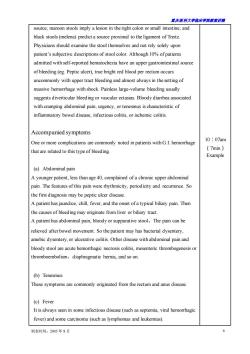
君庆医科大学脑床半院表来讲满 source;maroon stools imply a lesion in the right colon or small intestine,and black stools(melena)predicta source proximal to the ligament of Treitz Physicians should examine the stool themselves and not rely solely upon patient's subjective descriptions of stool color.Although 10%of patients admitted with self-reported hematochezia have an upper gastrointestinal source of bleeding(eg.Peptic ulcer),true bright red blood per rectum occurs uncommonly with upper tract bleeding and almost always in the setting of massive hemorrhage with shock.Painless large-volume bleeding usually suggests diverticular bleeding or vascular ectasias.Bloody diarrhea associate with cramping abdominal pain.urgency,or tenesmus is characteristic of inflammatory bowel disease,infectious colitis,or ischemic colitis. Accompanied symptoms One or more complications are commonly noted in patients withG.I.hemorrhage 10:07am that are related to this type of bleeding (7min) Example (a)Abdominal pain A younger patient,less than age 40,complained of a chronic upper abdominal pain.The features of this pain were rhythmicity,periodicity and.recurrence.So the first diagnosis may be peptic ulcer disease. A patient has jaundice,chill,fever,and the onset ofa typical biliary pain.Then the causes of bleeding may originate from liver or biliary tract. A patient has abdominal pain,bloody or suppurative stool.The pain can be relieved after bowel movement.So the patient may has bacterial dysentery. amebic dysentery,or ulcerative colitis.Other disease with abdominal pain and bloody stool are acute hemorrhagic necrosis colitis,mesenteric thrombogenesis or thromboembolism,diaphragmatic hemia,and soon (b)Tenesmus These symptoms are commonly originated from the rectum and anus disease. (c)Fever It is always seen in some infectious disease(such as septemia,viral hemorrhagic fever)and some carcinoma(such as lymphomas and leukemias). 制表时间:2005年8月
重庆医科大学临床学院教案讲稿 制表时间:2005 年 8 月 6 source; maroon stools imply a lesion in the right colon or small intestine; and black stools (melena) predict a source proximal to the ligament of Treitz. Physicians should examine the stool themselves and not rely solely upon patient’s subjective descriptions of stool color. Although 10% of patients admitted with self-reported hematochezia have an upper gastrointestinal source of bleeding (eg. Peptic ulcer), true bright red blood per rectum occurs uncommonly with upper tract bleeding and almost always in the setting of massive hemorrhage with shock. Painless large-volume bleeding usually suggests diverticular bleeding or vascular ectasias. Bloody diarrhea associated with cramping abdominal pain, urgency, or tenesmus is characteristic of inflammatory bowel disease, infectious colitis, or ischemic colitis. Accompanied symptoms One or more complications are commonly noted in patients with G.I. hemorrhage that are related to this type of bleeding. (a) Abdominal pain A younger patient, less than age 40, complained of a chronic upper abdominal pain. The features of this pain were rhythmicity, periodicity and. recurrence. So the first diagnosis may be peptic ulcer disease. A patient has jaundice, chill, fever, and the onset of a typical biliary pain. Then the causes of bleeding may originate from liver or biliary tract. A patient has abdominal pain, bloody or suppurative stool。The pain can be relieved after bowel movement. So the patient may has bacterial dysentery, amebic dysentery, or ulcerative colitis. Other disease with abdominal pain and bloody stool are acute hemorrhagic necrosis colitis, mesenteric thrombogenesis or thromboembolism,diaphragmatic hernia, and so on. (b) Tenesmus These symptoms are commonly originated from the rectum and anus disease. (c) Fever It is always seen in some infectious disease (such as septemia, viral hemorrhagic fever) and some carcinoma (such as lymphomas and leukemias). 10:07am (7min) Example
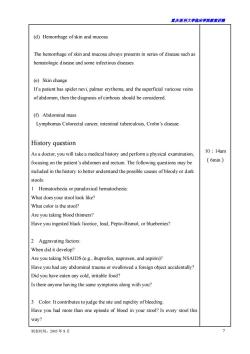
重庆医科大半床半院载未讲满 (d)Hemorrhage of skin and mucosa The hemorrhage of skin and mucosa always presents in series of disease such as hematologic disease and some infectious diseases. (e)Skin change If a patient has spider nevi,palmar erythema,and the superficial varicose veins of abdomen,then the diagnosis of cimhosis should be considered (f)Abdominal mass Lymphomas Colorectal cancer,intestinal tuberculosis,Crohn's disease. History question As a doctor,you will take a medical history and perform a physical examination, 10:14am focusing on the patient's abdomen and rectum.The following questions may be (6min) included in the history to better understand the possible causes of bloody or dark stools: 1 Hematochezia or paradoxical hematochezia: What does your stool look like? What color is the stool? Are you taking blood thinners? Have you ingested black licorice,lead,Pepto-Bismol,or blueberries? 2 Aggravating factors: When did it develop? Are you taking NSAIDS(e.g.,ibuprofen,naproxen,and aspirin)? Have you had any abdominal trauma or swallowed a foreign object accidentally? Did you have eaten any cold,irritable food? Is there anyone having the same symptoms along with you? 3 Color.It contributes to judge the site and rapidity of bleeding. Have you had more than one episode of blood in your stool?Is every stool this way? 制表时间:2005年8月
重庆医科大学临床学院教案讲稿 制表时间:2005 年 8 月 7 (d) Hemorrhage of skin and mucosa The hemorrhage of skin and mucosa always presents in series of disease such as hematologic disease and some infectious diseases. (e) Skin change If a patient has spider nevi, palmar erythema, and the superficial varicose veins of abdomen, then the diagnosis of cirrhosis should be considered. (f) Abdominal mass Lymphomas Colorectal cancer, intestinal tuberculosis, Crohn’s disease. History question As a doctor, you will take a medical history and perform a physical examination, focusing on the patient’s abdomen and rectum. The following questions may be included in the history to better understand the possible causes of bloody or dark stools: 1 Hematochezia or paradoxical hematochezia: What does your stool look like? What color is the stool? Are you taking blood thinners? Have you ingested black licorice, lead, Pepto-Bismol, or blueberries? 2 Aggravating factors: When did it develop? Are you taking NSAIDS (e.g., ibuprofen, naproxen, and aspirin)? Have you had any abdominal trauma or swallowed a foreign object accidentally? Did you have eaten any cold, irritable food? Is there anyone having the same symptoms along with you? 3 Color: It contributes to judge the site and rapidity of bleeding. Have you had more than one episode of blood in your stool? Is every stool this way? 10:14am (6min)
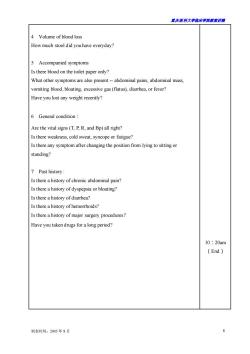
置庆医科大学临床半院麦素讲满 4 Volume of blood loss How much stool did you have everyday? 5 Accompanied symptoms Is there blood on the toilet paper only? What other symptoms are also present-abdominal pains,abdominal mass, vomiting blood,bloating,excessive gas(flatus),diarrhea,or fever? Have you lost any weight recently? 6 General condition: Are the vital signs (T,P.R,and Bp)all right? Is there weakness,cold sweat,syncope or fatigue? Is there any symptom after changing the position from lying to sittingor standing? 7 Past history: Is there a history of chronic abdominal pain? Is there a history of dyspepsia or bloating? Is there a history of diarrhea? Is there a history of hemorrhoids? Is there a history of major surgery procedures? Have you taken drugs for a long period? 10:20am (End 制表时间:2005年8月
重庆医科大学临床学院教案讲稿 制表时间:2005 年 8 月 8 4 Volume of blood loss How much stool did you have everyday? 5 Accompanied symptoms Is there blood on the toilet paper only? What other symptoms are also present - abdominal pains, abdominal mass, vomiting blood, bloating, excessive gas (flatus), diarrhea, or fever? Have you lost any weight recently? 6 General condition: Are the vital signs (T, P, R, and Bp) all right? Is there weakness, cold sweat, syncope or fatigue? Is there any symptom after changing the position from lying to sitting or standing? 7 Past history: Is there a history of chronic abdominal pain? Is there a history of dyspepsia or bloating? Is there a history of diarrhea? Is there a history of hemorrhoids? Is there a history of major surgery procedures? Have you taken drugs for a long period? 10:20am (End)
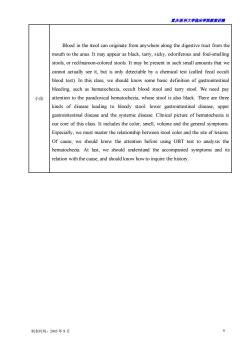
重庆医科大半脑床半院载未讲满 Blood in the stool can originate from anywhere along the digestive tract from the mouth to the anus.It may appear as black,tarry,sicky,odoriferous and foul-smelling stools,or red/maroon-colored stools.It may be present in such small amounts that we cannot actually see it,but is only detectable by a chemical test (called fecal occult blood test).In this class,we should know some basic definition of gastrointestinal bleeding.such as hematochezia,occult blood stool and tarry stool.We need pay 小结 attention to the paradoxical hematochezia,whose stool is also black.There are three kinds of disease leading to bloody stool:lower gastrointestinal disease,upper gastrointestinal disease and the systemic disease.Clinical picture of hematochezia is our core of this class.It includes the color,smell,volume and the general symptoms. Especially,we must master the relationship between stool color and the site of lesions. Of cause,we should know the attention before using OBT test to analysis the hematochezia.At last,we should understand the accompanied symptoms and its relation with the cause,and should know how to inquire the history. 制表时间:2005年8月
重庆医科大学临床学院教案讲稿 制表时间:2005 年 8 月 9 小结 Blood in the stool can originate from anywhere along the digestive tract from the mouth to the anus. It may appear as black, tarry, sicky, odoriferous and foul-smelling stools, or red/maroon-colored stools. It may be present in such small amounts that we cannot actually see it, but is only detectable by a chemical test (called fecal occult blood test). In this class, we should know some basic definition of gastrointestinal bleeding, such as hematochezia, occult blood stool and tarry stool. We need pay attention to the paradoxical hematochezia, whose stool is also black. There are three kinds of disease leading to bloody stool: lower gastrointestinal disease, upper gastrointestinal disease and the systemic disease. Clinical picture of hematochezia is our core of this class. It includes the color, smell, volume and the general symptoms. Especially, we must master the relationship between stool color and the site of lesions. Of cause, we should know the attention before using OBT test to analysis the hematochezia. At last, we should understand the accompanied symptoms and its relation with the cause, and should know how to inquire the history
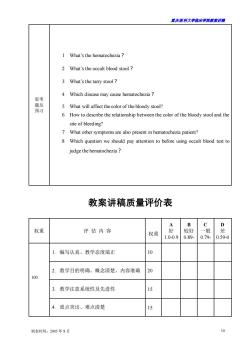
君庆医科大学脑床半院表来讲测 1 What's the hematochezia? 2 What's the occult blood stool 3 What's the tarry stool 4 Which disease may cause hematochezia? 思考 5 What will affect the color of the bloody stool? 6 How to describe the relationship between the color of the bloody stool and the site of bleeding? 7 What other symptoms are also present in hematochezia patient? 8 Which question we should pay attention to before using occult blood test to judge the hematochezia? 教案讲稿质量评价表 c 权重 评估内容 权重 好 差 1.0-0.90.89- 0.79. 059-0 1. 编写认真、教学态度端正 2.教学目的明确、概念清楚、内容准确 20 3.教学注意系统性及先进性 4.重点突出、难点清楚 15 制表时间:2005年8月 10
重庆医科大学临床学院教案讲稿 制表时间:2005 年 8 月 10 思考 题及 预习 1 What’s the hematochezia? 2 What’s the occult blood stool? 3 What’s the tarry stool? 4 Which disease may cause hematochezia? 5 What will affect the color of the bloody stool? 6 How to describe the relationship between the color of the bloody stool and the site of bleeding? 7 What other symptoms are also present in hematochezia patient? 8 Which question we should pay attention to before using occult blood test to judge the hematochezia? 教案讲稿质量评价表 权重 评 估 内 容 权重 A 好 1.0-0.9 B 较好 0.89- C 一般 0.79- D 差 0.59-0 100 1. 编写认真、教学态度端正 10 2. 教学目的明确、概念清楚、内容准确 20 3. 教学注意系统性及先进性 15 4. 重点突出、难点清楚 15
按次数下载不扣除下载券;
注册用户24小时内重复下载只扣除一次;
顺序:VIP每日次数-->可用次数-->下载券;
- 重庆医科大学:《实验诊断学》课程教学资源(PPT课件)第八讲 脑脊液常规及生殖系统检查.ppt
- 重庆医科大学:《实验诊断学》课程教学资源(PPT课件)第七讲 大便常规、免疫学检查及心肌标志物检查.ppt
- 重庆医科大学:《实验诊断学》课程教学资源(PPT课件)第六讲 肾功能检查(主讲:唐敏).ppt
- 重庆医科大学:《实验诊断学》课程教学资源(PPT课件)第四讲 血栓与出血检查(主讲:胥文春).ppt
- 重庆医科大学:《实验诊断学》课程教学资源(PPT课件)第三讲 骨髓细胞学检查、血型与输血.ppt
- 重庆医科大学:《实验诊断学》课程教学资源(PPT课件)第一讲 总论及血液一般检查(上).ppt
- 上海科学技术出版社:《实验诊断学——彩色图谱》书籍PDF电子版(主编:张丽霞、陈金宝).pdf
- 重庆医科大学:《实验诊断学》课程复习题集(无答案).doc
- 《实验诊断学》课程实验指导书 laboatoty diagnosis(共九章,含练习及答案).doc
- 重庆医科大学:《实验诊断学》课程教学资源(教案)第8讲 CSF生殖系统.doc
- 重庆医科大学:《实验诊断学》课程教学资源(教案)第7讲 大便 免疫 心肌.doc
- 重庆医科大学:《实验诊断学》课程教学资源(教案)第6讲 肾功能.doc
- 重庆医科大学:《实验诊断学》课程教学资源(教案)第2讲 血液(下).doc
- 重庆医科大学:《实验诊断学》课程实验教学大纲(供临床医学专业本科用).doc
- 重庆医科大学:《实验诊断学》课程理论教学大纲(供五年制临床医学、儿科医学、预防医学、麻醉医学、影像医学专业本科使用).doc
- 石河子大学:《妇产科护理学》课程教学课件(PPT讲稿)第四章 妊娠期妇女的护理.ppt
- 石河子大学:《妇产科护理学》课程教学课件(PPT讲稿)第二章 女性生殖系统解剖与生理.ppt
- 石河子大学:《妇产科护理学》课程教学课件(PPT讲稿)第一章 绪论 Obstetric and Gynecological Nursing.ppt
- 石河子大学:《妇产科护理学》课程教学课件(PPT讲稿)第六章 产褥期管理.ppt
- 石河子大学:《妇产科护理学》课程教学课件(PPT讲稿)第五章 分娩期妇女的护理.ppt
- 重庆医科大学:《诊断学》课程教学资源(授课教案)03 呕血.doc
- 重庆医科大学:《诊断学》课程教学资源(授课教案)09 病历与诊断.doc
- 重庆医科大学:《诊断学》课程教学资源(授课教案)08 腹部检查.doc
- 重庆医科大学:《诊断学》课程教学资源(授课教案)01 绪论与问诊.doc
- 重庆医科大学:《诊断学》课程教学资源(授课教案)02 水肿.doc
- 重庆医科大学:《诊断学》课程教学资源(授课教案)07 黄疸.doc
- 重庆医科大学:《诊断学》课程教学资源(授课教案)05 腹痛.doc
- 重庆医科大学:《诊断学》课程教学资源(授课教案)06 腹泻.doc
- 重庆医科大学:《诊断学》课程教学资源(授课教案)14 心电图.doc
- 重庆医科大学:《诊断学》课程教学资源(授课教案)11 心脏检查.doc
- 重庆医科大学:《诊断学》课程教学资源(授课教案)20 呼吸系统症状和体征.doc
- 重庆医科大学:《诊断学》课程教学资源(授课教案)13 循环系统主要症状与体征.doc
- 重庆医科大学:《诊断学》课程教学资源(授课教案)15 超声心动图检查.doc
- 重庆医科大学:《诊断学》课程教学资源(授课教案)12 血管检查.doc
- 重庆医科大学:《诊断学》课程教学资源(授课教案)10 发热.doc
- 重庆医科大学:《诊断学》课程教学资源(授课教案)19 胸部检查.doc
- 重庆医科大学:《诊断学》课程教学资源(授课教案)18 呼吸困难.doc
- 重庆医科大学:《诊断学》课程教学资源(授课教案)16 咳嗽、咳痰.doc
- 重庆医科大学:《诊断学》课程教学资源(授课教案)17 咯血.doc
- 医学临床本科《MRI诊断学》课程教学大纲 Magnetic Resonance Imaging Diagnosis.doc
